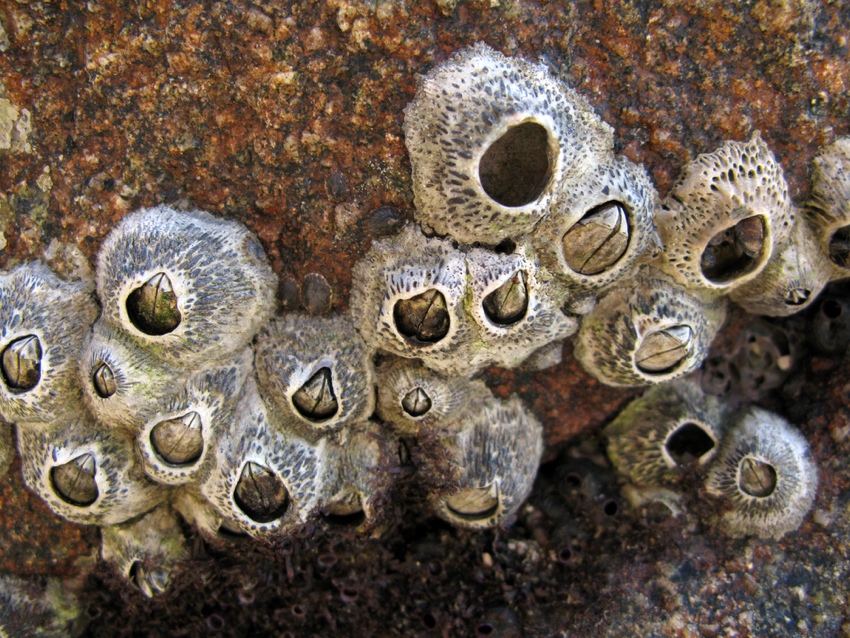Animal Sex: How Barnacles Do It

Barnacles are invertebrates related to crabs and lobsters. But unlike their crawly cousins, adult barnacles permanently attach to surfaces, raising an interesting question: How do these sessile creatures mate?
Numerous immobile invertebrates, including clams and sea anemones, reproduce via broadcast spawning, in which the animals release sperm and eggs into the water for external fertilization. But as Charles Darwin noted in monographs published in the 1850s, most barnacles actually reproduce via copulation, or more precisely, pseudo-copulation.
Like many other animals, barnacles only reproduce during the mating season. The exact timing of the mating season differs between species, but it generally runs from spring to early fall for intertidal barnacles, said zoologist and barnacle expert Richard Palmer, of the University of Alberta in Canada.
Most barnacles are hermaphrodites, meaning they have both male and female reproductive organs, and typically either function as a male or female partner during mating.
It's unclear what factors drive a barnacle to choose the temporary role it does, but "there are some theories that suggest it has to do with the number of immediately accessible partners," Palmer told Live Science, adding that situations involving a high density of closely packed barnacles will favor more of them assuming the "male" role.
The anatomy of barnacle sex
Mating is possible due to the crustacean's incredibly long penis.
Get the world’s most fascinating discoveries delivered straight to your inbox.
Barnacles have one of the longest penises relative to body size in the animal kingdom — in extreme cases, the penis can be up to 8 times the barnacle's body size, Darwin noted in his monographs. [The 7 Weirdest Animal Penises]
Interestingly, the length and thickness of an intertidal barnacle's penis depends on its environment, according to a 2008 study co-authored by Palmer.
In calm waters, barnacle penises are long and slender, allowing them to reach the maximum amount of partners possible. But wave-exposed, intertidal locales favor shorter, stouter penises, which are more easily controlled under turbulent conditions.
What's more, the size and shape of a barnacle's penis isn't set for life. "If you transplant them [from an exposed to calm area], their penises will get longer and more slender," Palmer said.
To mate, a male-functioning barnacle will insert its penis and release sperm into the mantle cavity (space between the shell and body) of a female-functioning barnacle — because sperm isn't released into the actual body, this is considered "pseudo-copulation."
The sperm induces the release of eggs, which are fertilized and develop into embryos and then larvae within the mantle cavity.
Multiple modes of reproduction
Scientists don't know exactly how barnacles know what sex role their neighbors are assuming, though barnacle penises do have chemosensory bristles that may help to zero-in on functional females.
"But if you watch them copulate, they basically just extend their penises and kind of go knocking on everybody's doors," Palmer said. "It doesn't look they're searching for any particular partner."
Once a receptive partner is found, however, mating can occur multiple times over a certain period, and involve multiple partners.
For instance, in a 2006 study of the barnacle Tetraclita japonica, researchers witnessed a single "female" accepting 582 penis insertions from 11 "males" over a period of about 8.5 hours (each insertion lasted, on average, about 2.4 seconds).
Research also suggests some species don't need to be submerged in water to mate. In a soon-to-be published study in the journal Marine Biology, Palmer and his colleagues found that the northeast Pacific gooseneck barnacle (Pollicipes polymerus) could extend its penis in air and mate in between periods of softly breaking waves.
Pseudo-copulation may be the norm for barnacles, but it's not the only way they reproduce.
A few years ago, Palmer and his colleagues found Pollicipes polymerus barnacles that were too far away from other adults to copulate, yet somehow carried fertilized eggs. Though some species of barnacles are known to self-fertilize, tests showed the fertilized eggs contained genetic material from other individuals, according to the researchers' 2013 study.
The find suggests that barnacles — Pollicipes polymerus, at the very least — sometimes mate via spermcasting, wherein functional males release into the water their sperm, which is then somehow captured by functional females.
Follow Joseph Castroon Twitter. Follow us @livescience, Facebook& Google+.



